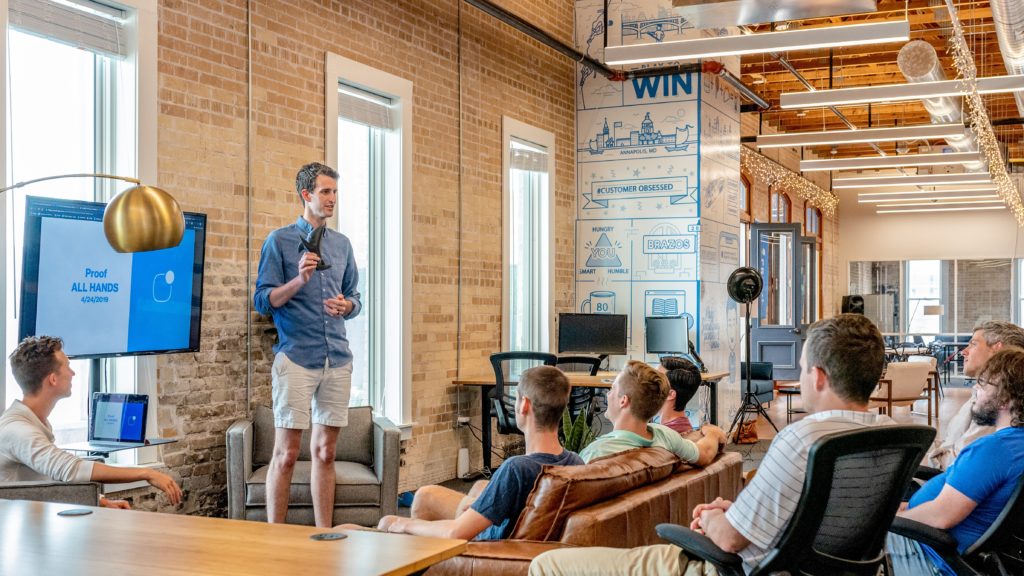DEX: 6 reasons why your organizations need to focus on it

Why your digital employee experience (DEX) is a necessity – not an option.
The digital workplace has changed the way we work and has transformed our workspace: automating office processes, improving ways of communicating with people anywhere in the world, and using the latest digital tools to support us in our roles.
With four different generations – the most ever – coexisting in the workforce, organizations know that in order to get the best out of each individual, they must accommodate work styles to fit these different ages and personalities. Now, more than ever before, organizations are meeting the digital expectations of their workforce.
This, in a nutshell, is the basis for DEX: a seamless relationship between employees and tech is the essence of the digital workplace experience.
With the increase in digital services on offer, companies are aware of how their technology infrastructure is impacting on the working life of the employee.
Building a connected digital workplace
From cohesive relationships with remote workers to sourcing the best digital tools for the job, the working lives of your employees need to be analyzed. This can then provide a true understanding of what can enable higher productivity, increased workplace happiness, and improved efficiency.
So how do you ensure your organization is leading the way in creating a positive digital employee experience? We look at six aspects of working life and how our digital tools can work to support, engage, and develop our employees.
The workplace

The workplace is no longer a place where people clock in, clock out, and get paid. Work is providing a far richer experience than ever before. The boundaries between work and home are now blurred, and the ‘always on’ environment is creating a new reality.
Through integrated technology, people feel more empowered, more in control, and more able to shape their position in the workplace. If organizations can improve what people encounter, observe, and feel throughout the working day, it goes a long way to enhance productivity, satisfaction, and retention.
The result delivers a DEX that has broken down silos between departments, provided better access to digital tools for remote workers, and increased engagement across the workforce. People have greater insights into the work of their colleagues, wherever they are in the world.
Office spaces reflect how we work, but recently, digital technology and flexible working have meant the “office landscape” has had to adapt accordingly. New developments have impacted not just how we work, but where we work. Workers have found that incoming tech has helped create a situation where they control their environment, which is contrary to tradition. With so many tools available to aid work at home or remotely, there is less focus on commuting to a physical space to work. The future will continue to see how we can recreate a productive, flexible working environment anywhere, and create a DEX that is unique to every worker.
More flexibility Modern life sees employees juggling a lot of priorities with homelife, dependants, and work-life. Commuting to an office can take up valuable time, and long journeys or unreliable transport can create complexities that are not conducive to work. However, digital tools have allowed the ability to work from any location. This has created flexibility in our work lives that hasn’t been experienced before.
More efficiency With more fluidity in the workplace, efficiency is increased. If the digital workplace allows employees to work from any location, they can log on and start work earlier than their traditional hours.
Higher productivity Of course, the technology exists to ease complex tasks. Productivity is given a boost by tech taking over repetitive and mundane tasks. In some roles, the ability to skip the afternoon lull and make up the hours in the evening also increases productivity.
Leadership

The digital workplace can act as an enormous benefit to business leaders: from being able to be seen as a knowledge leader to being able to inspire by leading by example. The digital workplace is the perfect place to practice transparency, integrity, and accountability. These crucial behaviors, in turn, improve the experience that employees receive as a result.
Increased visibility: In a large organization, it’s easy for key figures to lose visibility. However, a digital workplace can form a connection between the top level and the rest of the workforce, meaning management can still present leadership qualities in even the largest of organizations. Thanks to tools that enable live blogging, video calls, mobile intranet, and more, the digital workplace allows connections to all members of the workforce without ever needing to meet them in person.
Improved communication: The digital workplace offers a richer way of communication for leaders. From blogs to comments, to input in online discussions, photos, and video – senior level is now able to communicate in a far more profound way, allowing them to reach out to people.
Approachability: Organizations know that the age of a faceless C-suite is over. Employees need not only to recognize their leaders but can share ideas with them, ask for advice and work alongside them. This can allow businesses to really galvanize and increase engagement amongst the workforce.
Training

While vital to the growth and development of the business, training can be considered a rather dry, mandatory process. It can also be a burden on an organization that has not correctly implemented a structure yet. HR departments can struggle to achieve efficient training, with time and resources acting as obstructions.
In short, the employee’s encounter with training is rarely seen as a five-star experience. Long sessions that interrupt the working day, a revision that needs to be taken place out of hours and modules that lack cohesion – there is major friction between what needs to be achieved, and how it is achieved. The digital workplace is changing all this, however. E-learning has developed to become an incredibly sophisticated method in which to train up employees.
Building a connected digital workplace
More agility: e-Learning can enable the user to carry out their day-to-day duties while studying. Workers can fit it into any scenario, whether it’s on the road, at home or on scheduled breaks, and the results feed through in real-time back to the relevant departments.
More effective: Depending on the structure, workers can be alerted to any wrong answers and go back to study the specific module. Or they can be awarded badges that can be displayed on the social areas of the site to recognize their progress and achievement.
More adaptable: This style of training allows the user to progress at a pace that suits them, at any location. And when you have an employee who is learning and exploring, they’re better at their jobs, helpful to fellow colleagues, and provide a better customer experience.
Collaboration

Collaboration has many advantages in the workplace. It eases the burden on individuals, makes sure work gets distributed evenly, makes employees more responsible, and increases motivation levels across the various teams. Not to mention the problem-solving, silo-breaking, and learning benefits which come along with a successful collaborative process. In short, for an organization to work efficiently, it needs to know how to collaborate well.
Technology plays a prominent role in collaboration within the modern workplace. It has helped create new opportunities for businesses and overcome the challenges that a global economy presents. And of course, when there are teamwork and collaboration within an organization, great things can be achieved.
Communities: When your digital workplace has a focus on communication and collaboration, your users can experience virtual communities. These break down the geographical barriers that globalized workforces have to contend with.
Access to information: Even for those who do work in the same office with one another, digital collaboration platforms such as intranets can empower employees. They do this by breaking down teams or departmental silos, connecting them with other skill sets, and providing a searchable, centrally located knowledge base.
Worldwide: Now, collaboration can take place anywhere in the world. Communication is no longer heavily weighted towards face-to-face interactions, and individuals don’t have to sit next to one another to work on a shared document simultaneously.
Customers

The experiences between customers and employees is inextricably linked. You cannot achieve excellent customer service without your frontline having a great employee experience.
There has been much focus on creating an incredible experience for customers – from the design of the packaging to the welcome they receive on walking into the shop. Today, businesses want to deliver these experiences to their own employees to deepen engagement, improve user satisfaction, and build loyalty. Organizations have seen that by the best way of improving the employees’ experience is by improving the customer journey.
Better customer service: An organization needs to furnish their digital workplace with all the relevant information that their workforce needs. When an employee has fast, easy access, jobs improve, and so, therefore, does the customer experience.
More engagement: Gamification and e-learning are popular methods of interactive learning which boost employee engagement and the ability to take on large or complex batches of information more easily. This more efficient training allows the employee to become more engaged with their role and provide a better experience to the customer.
Employee recognition: As an organization progresses with its training and developing, performance management should go hand-in-hand. Implementing performance appraisals, evaluations, and employee recognition programs give each member an idea of their progress, helps to retain the worker, and ensures continued development in their role and understanding of their job.
Tools and IT

One of the most important aspects of DEX is that of the digital tools that the employee interacts with. As workplaces progress, the IT ecosystem becomes more sophisticated.
This means that today’s IT must consider the bigger picture of what tomorrow’s plans have instore. Today, employees expect their workplace IT to closely resemble the simplicity and ease of their digital experience at home. If the cracks in your IT are showing now, the workforce will lose faith in their workplace ever matching their growing needs.
Consumer-grade tech experience: These days, your employees expect a consumer-grade tech experience. Anything less will cause frustrations, resentment, and confusion – which, of course, affects the customer experience. Consumer-grade is fast, easy-to-use, and intuitive, allowing the workforce to access one source of truth to increase your competitive advantage, drive productivity, and improves customer service.
A tailored experience: Personalized consumer digital experiences in the workplace will soon be considered standard. As AI advances, this will become increasingly niche and sophisticated. Employees will no longer accept or engage with internal content that isn’t tailored to them as individuals.
BYOD: More and more organizations are welcoming a ‘bring your own device’ policy, which can increase worker satisfaction and convenience. BYOD policies also boost productivity by allowing employees to use devices they are familiar and comfortable with.
As the 21st century becomes more reliant on technology, organizations must get a handle on the relationship between tech and employees.
As we work harder, faster and more competitively, we need technology in order to progress. Tech makes complex tasks easy; it helps us solve problems more quickly, it can process large amounts of data faster than a human. To benefit from this, we need to be creating a seamless relationship with technology and the workforce: which is the essence of DEX. The impact this has offers boundless benefits to the individual and the company – as well as on customers and the community on a wider scale.
And for businesses today, there is no alternative. Organizations need to embrace technology and keep up with its ever-evolving landscape in order to stay ahead. The fact that DEX is a necessity, not an option will dawn on the majority of businesses soon. But with a head start, you will gain a competitive edge over your rivals.

